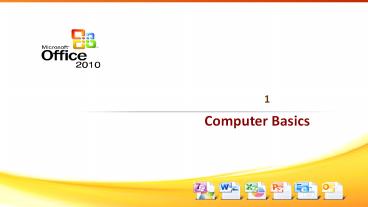Basic Computer & MS Office - PowerPoint PPT Presentation
Title:
Basic Computer & MS Office
Description:
In this Present About Basic Computer & MS Office 2010 Information in . I have one by one type about Basic Computer and Basic MS Office 2010. Furthermore visit – PowerPoint PPT presentation
Number of Views:94
Title: Basic Computer & MS Office
1
(No Transcript)
2
Objectives
- At the end of this session, students will be able
to - Define a computer
- Define basic computer terms
- Identify the different types of computers
- Identify the different parts of a computer
- Describe the working of a computer
Www.Learn2Free.com
3
Introduction to Computers
- A computer
- Is an electronic machine
- Allow users to store information
- Enables to carry out different operations to
process that information
Computer Basics / Session 1
4
Uses of Computers
- A computer allow users to store information in
various formats and process it to perform
different actions - Process complex data
- Access information remotely
- Watch movies for entertainment
- The different tasks that are executed by an user
using a computer are - Store, format, and print text files
- Write, test, and execute different types of
software - Maintain records of financial statements
- Present information in a visually appealing
manner - Access various kinds of information and resources
from all over the world - Exchange electronic mails with contacts
- Watch movies, listen to music, and play games
5
Terminology 1-7
- The description of the following terms helps the
user to understand the working of the computer in
detail - Hardware
- Are physical components of a computer
- Includes all the mechanical, electronic and
magnetic parts of a computer - Software
- Is a program that enables the computer to operate
- Is a set of codes or rules in electronic form
- Instructs the computer about actions to be taken
- Referred as a program or an application
- Example - Internet Explorer is a software for
accessing the Internet
Computer Basics / Session 1
6
Terminology 2-7
- Operating System (OS)
- Is collective software that integrates various
software programs - Acts as an interface between the user and the
computer - Manages interaction between software and hardware
resources - Example - Microsoft Windows is an operating
system - Data
- Is a distinct piece of information present in a
form suitable for computer processing - Is different from programs
- Can exist in various formats, such as electronic
format or number or text on a paper - Example - Numbers entered by the user are data
for the calculator program
Computer Basics / Session 1
7
Terminology 3-7
- Workstation
- Is a type of computer used for professional tasks
that require high performance - Have the capacity to store and process large
quantities of data - Have more powerful resources than regular desktop
computers - Linked together to form a network of computers
known as local area network - Booting
- Is a process by which the operating system loads
and starts when the computer is turned on
Computer Basics / Session 1
8
Terminology 4-7
- Units of Memory
- Represents data by presence or absence of
electronic charge - Uses only two numbers to represent any kind of
data known as binary data - A Bit or binary digit
- Is the smallest unit of data that can be stored
on a machine - Can have only one of the two possible values, 0
or 1 - Is not suitable to measure data in large
quantities - Bytes
- Are series of bits combined into larger units to
obtain meaningful information.
Computer Basics / Session 1
9
Terminology 5-7
- The table lists the units of measurement of
computer data
Higher Unit Lower Unit
1 Byte 8 Bits
1 Kilobyte (KB) 1024 Bytes
1 Megabyte (MB) 1024 KB
1 Gigabyte (GB) 1024 MB
1 Terabyte (TB) 1024 GB
Computer Basics / Session 1
10
Terminology 6-7
- Units of Speed kHz, MHz, GHz
- All electronic components work on a clock signal
- The number of oscillations per second determines
the speed of the device - The table lists the different units of speed
Unit of Speed Number of Clock Cycles
Kilohertz (kHz) One thousand clock cycles per second
Megahertz (MHz) One million clock cycles per second
Gigahertz (GHz) One billion clock cycles per second
Computer Basics / Session 1
11
IT COURSES AVAILABLE VISIT BELOW SITES.
- WWW.ONLINEITTUTS.COM
- WWW.LEARN2FREE.COM
- Complete Video Courses Available in Urdu/Hindi
Language.

